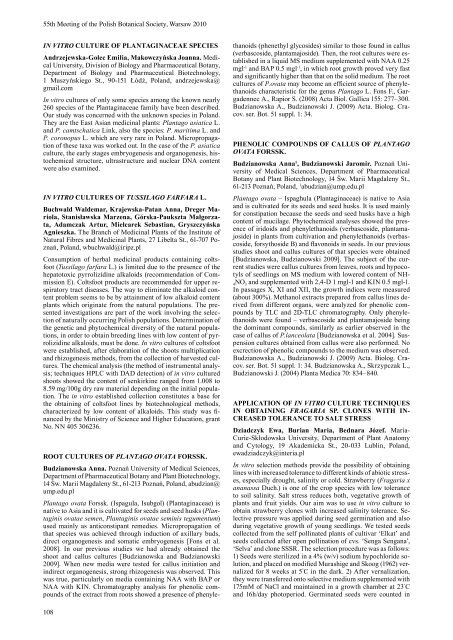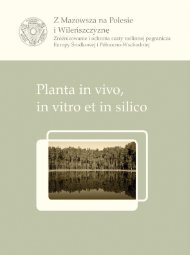acta societatis botanicorum poloniae - LV Zjazd Polskiego ...
acta societatis botanicorum poloniae - LV Zjazd Polskiego ...
acta societatis botanicorum poloniae - LV Zjazd Polskiego ...
You also want an ePaper? Increase the reach of your titles
YUMPU automatically turns print PDFs into web optimized ePapers that Google loves.
55th Meeting of the Polish Botanical Society, Warsaw 2010<br />
in vitro CULTUrE OF PLANTAGINACEAE SPECIES<br />
Andrzejewska-Golec Emilia, Makowczyńska Joanna. Medical<br />
University, Division of Biology and Pharmaceutical Botany,<br />
Department of Biology and Pharmaceutical Biotechnology,<br />
1 Muszyńskiego St., 90-151 Łódź, Poland, andrzejewska@<br />
gmail.com<br />
In vitro cultures of only some species among the known nearly<br />
260 species of the Plantaginaceae family have been described.<br />
Our study was concerned with the unknown species in Poland.<br />
They are the East Asian medicinal plants: Plantago asiatica L.<br />
and P. camtschatica Link, also the species: P. maritima L. and<br />
P. coronopus L. which are very rare in Poland. Micropropagation<br />
of these taxa was worked out. In the case of the P. asiatica<br />
culture, the early stages embryogenesis and organogenesis, histochemical<br />
structure, ultrastructure and nuclear DNA content<br />
were also examined.<br />
in vitro CULTUrES OF tussilAGo fArfArA L.<br />
Buchwald Waldemar, Krajewska-Patan Anna, dreger Mariola,<br />
Stanisławska Marzena, Górska-Paukszta Małgorzata,<br />
Adamczak Artur, Mielcarek Sebastian, Gryszczyńska<br />
Agnieszka. The Branch of Medicinal Plants of the Institute of<br />
Natural Fibres and Medicinal Plants, 27 Libelta St., 61-707 Poznań,<br />
Poland, wbuchwald@iripz.pl<br />
Consumption of herbal medicinal products containing coltsfoot<br />
(Tussilago farfara L.) is limited due to the presence of the<br />
hepatotoxic pyrrolizidine alkaloids (recommendation of Commission<br />
E). Coltsfoot products are recommended for upper respiratory<br />
tract diseases. The way to eliminate the alkaloid content<br />
problem seems to be by attainment of low alkaloid content<br />
plants which originate from the natural populations. The presented<br />
investigations are part of the work involving the selection<br />
of naturally occurring Polish populations. Determination of<br />
the genetic and phytochemical diversity of the natural populations,<br />
in order to obtain breeding lines with low content of pyrrolizidine<br />
alkaloids, must be done. In vitro cultures of coltsfoot<br />
were established, after elaboration of the shoots multiplication<br />
and rhizogenesis methods, from the collection of harvested cultures.<br />
The chemical analysis (the method of instrumental analysis;<br />
techniques HPLC with DAD detection) of in vitro cultured<br />
shoots showed the content of senkirkine ranged from 1.008 to<br />
8.59 mg/100g dry raw material depending on the initial population.<br />
The in vitro established collection constitutes a base for<br />
the obtaining of coltsfoot lines by biotechnological methods,<br />
characterized by low content of alkaloids. This study was financed<br />
by the Ministry of Science and Higher Education, grant<br />
No. NN 405 306236.<br />
rOOT CULTUrES OF PlAntAGo ovAtA FOrSSK.<br />
Budzianowska Anna. Poznań University of Medical Sciences,<br />
Department of Pharmaceutical Botany and Plant Biotechnology,<br />
14 Św. Marii Magdaleny St., 61-213 Poznań, Poland, abudzian@<br />
ump.edu.pl<br />
Plantago ovata Forssk. (Ispagula, Isubgol) (Plantaginaceae) is<br />
native to Asia and it is cultivated for seeds and seed husks (Plantaginis<br />
ovatae semen, Plantaginis ovatae seminis tegumentum)<br />
used mainly as anticonstipant remedies. Micropropagation of<br />
that species was achieved through induction of axillary buds,<br />
direct organogenesis and somatic embryogenesis [Fons et al.<br />
2008]. In our previous studies we had already obtained the<br />
shoot and callus cultures [Budzianowska and Budzianowski<br />
2009]. When new media were tested for callus initiation and<br />
indirect organogenesis, strong rhizogenesis was observed. This<br />
was true, particularly on media containing NAA with BAP or<br />
NAA with KIN. Chromatography analysis for phenolic compounds<br />
of the extract from roots showed a presence of phenyle-<br />
108<br />
thanoids (phenethyl glycosides) similar to those found in callus<br />
(verbascoside, plantamajoside). Then, the root cultures were established<br />
in a liquid MS medium supplemented with NAA 0.25<br />
mgl -1 and BAP 0.5 mgl -1 , in which root growth proved very fast<br />
and significantly higher than that on the solid medium. The root<br />
cultures of P.ovata may become an efficient source of phenylethanoids<br />
characteristic for the genus Plantago L. Fons F., Gargadennec<br />
A., Rapior S. (2008) Acta Biol. Gallica 155: 277– 300.<br />
Budzianowska A., Budzianowski J. (2009) Acta. Biolog. Cracov.<br />
ser. Bot. 51 suppl. 1: 34.<br />
PHENOLIC COMPOUNdS OF CALLUS OF PlAntAGo<br />
ovAtA FOrSSK.<br />
Budzianowska Anna 1 , Budzianowski Jaromir. Poznań University<br />
of Medical Sciences, Department of Pharmaceutical<br />
Botany and Plant Biotechnology, 14 Św. Marii Magdaleny St.,<br />
61-213 Poznań, Poland, 1 abudzian@ump.edu.pl<br />
Plantago ovata – Ispaghula (Plantaginaceae) is native to Asia<br />
and is cultivated for its seeds and seed husks. It is used mainly<br />
for constipation because the seeds and seed husks have a high<br />
content of mucilage. Phytochemical analyses showed the presence<br />
of iridoids and phenylethanoids (verbascoside, plantamajoside)<br />
in plants from cultivation and phenylethanoids (verbascoside,<br />
forsythoside B) and flavonoids in seeds. In our previous<br />
studies shoot and callus cultures of that species were obtained<br />
[Budzianowska, Budzianowski 2009]. The subject of the current<br />
studies were callus cultures from leaves, roots and hypocotyls<br />
of seedlings on MS medium with lowered content of NH-<br />
4NO 3 and supplemented with 2,4-D 1 mgl-1 and KIN 0.5 mgl-1.<br />
In passages X, XI and XII, the growth indices were measured<br />
(about 300%). Methanol extracts prepared from callus lines derived<br />
from different organs, were analyzed for phenolic compounds<br />
by TLC and 2D-TLC chromatography. Only phenylethanoids<br />
were found – verbascoside and plantamajoside being<br />
the dominant compounds, similarly as earlier observed in the<br />
case of callus of P.lanceolata [Budzianowska et al. 2004]. Suspension<br />
cultures obtained from callus were also performed. No<br />
excrection of phenolic compounds to the medium was observed.<br />
Budzianowska A., Budzianowski J. (2009) Acta. Biolog. Cracov.<br />
ser. Bot. 51 suppl. 1: 34. Budzianowska A., Skrzypczak L.,<br />
Budzianowski J. (2004) Planta Medica 70: 834– 840.<br />
APPLICATION OF in vitro CULTUrE TECHNIqUES<br />
IN OBTAINING frAGAriA SP. CLONES WITH IN-<br />
CrEASEd TOLErANCE TO SALT STrESS<br />
dziadczyk Ewa, Burian Maria, Bednara Józef. Maria-<br />
Curie-Skłodowska University, Department of Plant Anatomy<br />
and Cytology, 19 Akademicka St., 20-033 Lublin, Poland,<br />
ewadziadczyk@interia.pl<br />
In vitro selection methods provide the possibility of obtaining<br />
lines with increased tolerance to different kinds of abiotic stresses,<br />
especially drought, salinity or cold. Strawberry (Fragaria x<br />
ananassa Duch.) is one of the crop species with low tolerance<br />
to soil salinity. Salt stress reduces both, vegetative growth of<br />
plants and fruit yields. Our aim was to use in vitro culture to<br />
obtain strawberry clones with increased salinity tolerance. Selective<br />
pressure was applied during seed germination and also<br />
during vegetative growth of young seedlings. We tested seeds<br />
collected from the self pollinated plants of cultivar ‘Elkat’ and<br />
seeds collected after open pollination of cvs. ‘Senga Sengana’,<br />
‘Selva’ and clone SSSR. The selection procedure was as follows:<br />
1) Seeds were sterilized in a 4% (w/v) sodium hypochloride solution,<br />
and placed on modified Murashige and Skoog (1962) vernalized<br />
for 8 weeks at 5 ° C in the dark. 2) After vernalization,<br />
they were transferred onto selective medium supplemented with<br />
175mM of NaCl and maintained in a growth chamber at 23 ° C<br />
and 16h/day photoperiod. Germinated seeds were counted in



